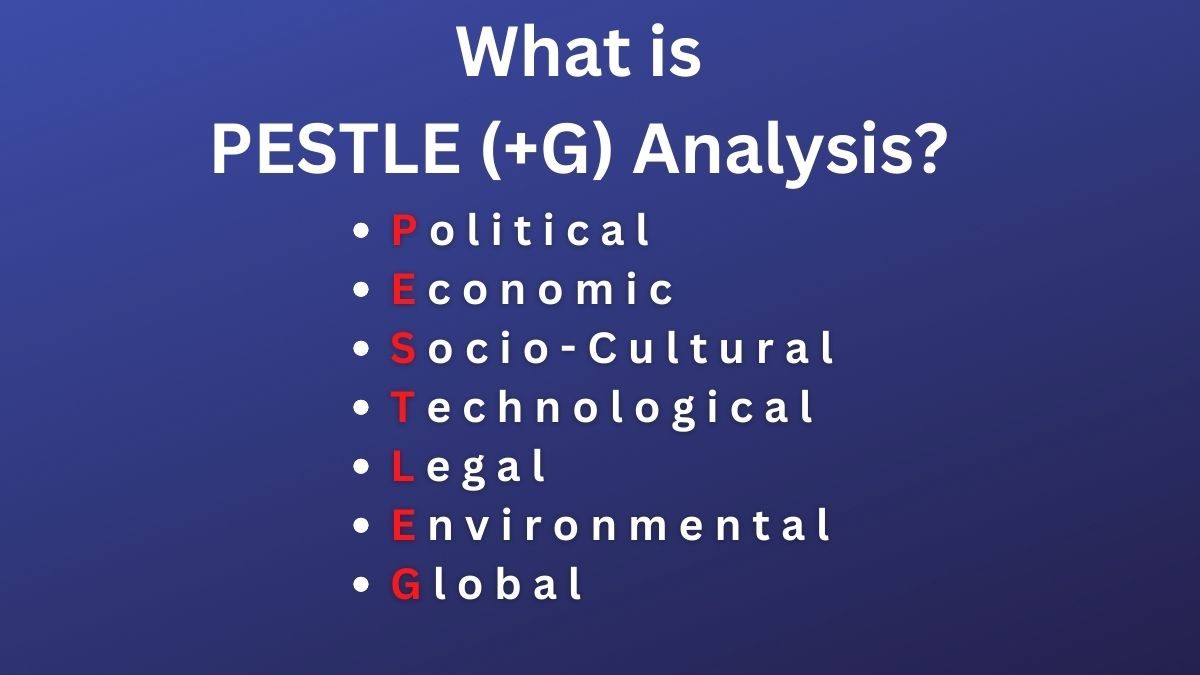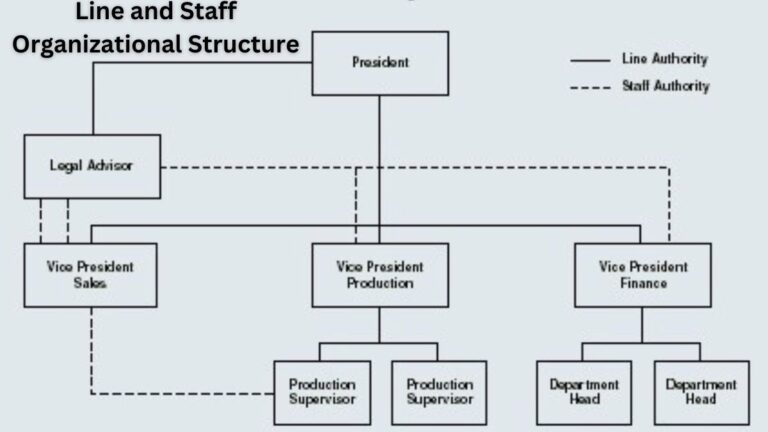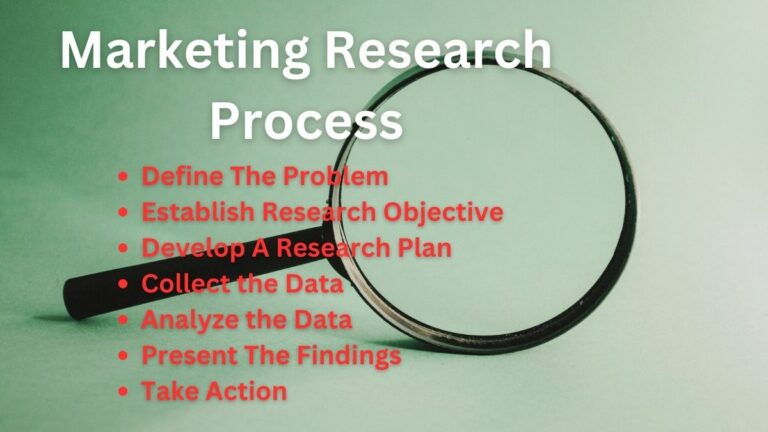What is PESTLE (+G) Analysis? Definition, Components, Importance, Examples, & Pros/Cons
Suppose you made a product you thought people would like and distributed it to the market. But you did not get the expected sales or expected results. After some time you realize that you have successfully wasted your money, efforts, and time. This is what happens when you launch a new product or expand your business without doing a PESTLE analysis.
PESTLE is an effective marketing and business analysis tool that offers you insightful information about the market that you can use in planning, product development, and business expansion processes. Here, we will discuss what the PESTLE analysis is, its components/factors, its importance, and its pros/cons.
What is PESTLE Analysis?
PESTLE analysis is an effective tool to study the external factors likely impact to the performance, operation, profit, growth, and existence of an organization.
In simple words, it is a tool to study the external business environment factors. It examines the likely influence of the macro environment’s factors on organizational performance. It lets us understand the market trends and possible opportunities and threats a business may confront.
PESTLE analysis is a popular marketing as well as business analysis framework that you can use to understand what is happening outside your organization. Its factors include all factors of the general/macro-environment.
The PESTLE is the mnemonic of Political, Economic, Social, Technological, Legal, and Environmental Factors. Formerly this was only at PEST analysis i.e. the combination of political, economic, socio-cultural, and technological.
Later with the concern of legal and environmental issues, the PEST was expanded to PESTLE where additional legal and environmental factors were added. And, again the latest addition to the PESTLE framework is global factors that make it PESTLEG.
Today, due to globalization’s impact it is essential to study global factors. Hence, the latest PEST analysis is the PESTLEG analysis whose full form is P for Political, E for Economic, S for Socio-Cultural, T for Technological, L for Legal, E for Environmental, and G for Global Factors.
What is the Objective of PESTLE Analysis?
The main objective of PESTLE analysis includes the following:
- Identification of market trends.
- Identification of potential opportunities.
- Identification of probable threats.
- And, providing information about the external environment’s factors that may have an impact on business performance.
Components/Factors of PESTLE Analysis
Let’s understand each factor of the PESTLE analysis.
Political Factors
Governments have a great influence on the performance and existence of an organization. The political factors include the likely impact of government actions and decisions on the organization’s operations and performance.
Read Also: What is Decision-Making?
When a government amends or changes some regulations businesses have to be updated with them. Some main political factors include:
- Political Stability
- Political Structure
- Political Philosophy
- Tax Policy
- Tariffs and Non-Tariffs Barriers
- Bureaucratic Structure
- Government-Business Relationship
- Constitution
- Political Parties
To successfully run the business you should be aware of the political factors of the nation where your business operates. For example, if tax policy changes it affects your business earnings and income distribution.
Similarly, if the nation is in favor of a democratic political philosophy the private companies will prosper there. And, if the nation follows totalitarian political ideology every business will be in control of the government.
Economic Factors
Economic factors include the aspects that determine a nation’s economic performance which have a significant influence on the profitability of your organization. Every organization wants to operate in an economy that is stable, moreover, which has a high growth rate.
Economic factors include:
- GDP
- Employment Rate
- Inflation
- Interest Rate
- Monitory Policy
- Fiscal Policy
- Industrial Policy
- Balance of Payments
- Income Level
- Business Cycles
- Economic Integration
- Economic System (Market, Command, Mix)
These economic factors have a significant impact on your organization’s performance and profitability. You should be known how these factors can influence your organization’s profitability.
For example, when the inflation rate is high you have to charge higher prices for your products but what if people’s income level does not increase – this certainly reduces the purchasing power of people. If people do not buy your products your sales will not increase and you may face losses.
Related: What is Pricing?
Similarly, if the monetary policy changes the interest rate of the market will be impacted. Keeping a close on these economic factors will help you to adjust accordingly.
Socio-Cultural Factors
Socio-Cultural factors of pestle analysis present the social environment of the market. A business operates in society and it must be aware of the norms and values of that society.
Also Read: Societal Marketing Concept
People’s and society’s habits, preferences, attitudes, needs, wants, etc. will have an impact on the performance of a business as that determines when and why they engage with the products and services. Socio-cultural factors include:
- Demographics
- Attitudes
- Buying Behavior
- Needs, Wants, and Preferences
- Beliefs
- Religion
- Culture
- Language
- Tradition
- Education
- Family Structure
- Social Institutions
- Values and Norms
- Income Distribution
- Taste
- Attitude to Work
It is essential to understand how these socio-cultural factors influence people or customers to respond to organizational actions. Understanding the needs, wants, tastes and preferences of society will let you make their desired products and employ the right marketing campaigns that have a greater success rate to get positive responses.
Take the example of Nepal where in the time of their Dashain and Tihar (The Greatest Festival of Nepal) the demand for vehicles (especially bikes) is very high. As such most companies offer discounts and the sales of bikes are increasing every year.
Technological Factors
It is obvious that every business of today is somehow connected with technology. The technological factors are related to technological innovation and development that could influence the market, business, or industry’s performance.
Technologies are changing very quickly keeping a close eye on technological development has been an essential task for managers today. The technology has reached the digitalization form that has been once in the manual stage. The main technological factors include:
- The pace of innovation and technology development
- Technology Transfer
- Research and development budget
- Changes in digital or mobile technology
- Automation
- Robotics and AI
It’s been said that the early adopters of the new technology enjoy huge benefits and get a greater market share than those who follow the implemented technologies.
In addition, in this digital world, you should give more focus on effectively utilizing digital technology but your consideration must also be on employing new ways to produce products, distribute them, and connect with clients.
Legal Factors
To successfully run your business you should also understand what is legal and what is illegal to do within the territory of the nation your business exists in. Legal factors include the legal laws and rules an organization must have to follow. Some legal factors include:
- Business Laws
- Labor Laws
- Health and Safety Laws
- Consumer Law
- Consumer Protection
- Industry Regulation
- Law Administrators
- Employment Legislation
- Intellectual Property Rights (IPRs)
It is critical your business must abide by these factors to legally and peacefully perform business activities. For example, your business must pay the minimum salary to the people as stated in the law. You should be updated and if the law changes or increases the minimum salary of laborers (or office employees) you should have to implement it as soon as possible.
Environmental Factors
Environmental factors include the impact on the physical environment and ecological aspects. With the increases in environmental pollution, global warming, indiscriminate use of natural resources, etc. the concern for the natural environment protection has been an inevitable task for businesses.
The environmental factors state that companies must be aware of environmental health and should manufacture products that are environmentally friendly. Some of the environmental factors companies should be aware of include:
- Climate Change
- Global Warming
- Energy Consumption
- Environment Protection Laws
- Waste Disposal
- Carbon Footprints
- Recycling Procedures
- Environment Sustainability
As such the importance of CSR and sustainable development have become critical in how businesses should conduct their operations. As such for long-term success companies must have to make products that are qualitative and do not harm natural health.
Global Factors
Global factors are the latest addition to the PESTLE analysis which addition makes PESTLE to the PESTLEG analysis. Due to the globalized economy, companies also have to think globally.
Since globalization is here a national company directly or indirectly is being affected by global factors like international products, international business practices, international politics, international culture, lifestyles, etc.
Read Also: What is Marketing Mix?
As such, understanding the above factors from P to E will not get complete information about the external environment’s factors unless the G i.e. global factors are not studied.
Importance of PESTLE Analysis
Why PESTLE analysis is important? It is a great tool to understand the broad facts about external factors that could have significant impacts on organizations’ performance.
Understanding the probable trends, opportunities, threats, and challenges companies will make better plans to exploit opportunities and mitigate the challenges. The reasons why pestle analysis is important to your business can also be pointed out in the following ways:
- Product Development – As I already mentioned, Pestle gives necessary information about the market, competition, prospects’ needs, and preferences which helps to produce the right products that have greater chances of acceptance.
- Exploit Opportunities – Being early aware of potential opportunities you can make better plans and hire skilled employees to effectively exploit the opportunities when they arrive.
- Mitigate Threats – Offering information about probable threats and opportunities is one of the important characteristics of pestle analysis. The threats can be effectively mitigated when they are already known before actually happen.
- Helps In Strategic Planning – By clearly studying and evaluating the long-term impacts of external forces trends managers can also formulate effective strategic plans.
- Keeps Updated – The business environment is dynamic as such being updated with new trends and changes is necessary.
- Workforce Management – How many and what types of employees your business will need can also be determined by studying the probable trends.
- Competitive Advantage – External factors also offer a lot of information about the tactics used by competitors and what they are going to use which helps you make better strategies and products better than competitors.
Advantages and Disadvantages of PESTLE Analysis
PESTLEG is an essential tool for studying the different external factors which also have some pros and cons. These include:
Advantages:
- PESTLE analysis is an easy tool to use.
- Can let you foresee the potential threats and helps to mitigate them.
- Provides early message of potential opportunities.
- Helps to understand future trends.
- Keeps up to date with happening external factors.
- Helps to design competitive plans and policies.
Disadvantages:
- Since it is easy to use most experts say it is not an as effective and comprehensive tool as much as it claims.
- It does not consider the analysis of the internal environment of organizations.
- As the external environment consists of too much information it takes more time to analyze and finalize the decision.
Examples of PESTLE Analysis
Most of the companies today are conducting pestle analysis to understand the market and deliver better customer value. Let’s look at some examples of pestle analysis and how it has influenced the company’s performance.
Coca-Cola
Coca-Cola is one of the largest non-alcoholic American beverage companies. Let’s look at Coca-Cola’s pestle analysis.
Political Factors
- Due to trade sanctions between USA and Burma, the sale of Coca-Cola was banned in Burma. And, the sales were restarted after long six years when the sanctions were suspended.
- Cuba and North Korea still are two countries that have prohibited the sale of Coca-Cola due to some political conditions.
Economic Factors
- In 2019, despite increases in its product price due to tariff barriers, it reported an 8% growth in its revenue.
- There is a free and fair trade agreement for Coca-Cola’s products between Mexico, Canada, and the USA.
Socio-Cultural Factors
- In 2014, the campaign named #shareacoke helped the company to connect with more people and build a good social media presence.
- The online Coca-Cola store also lets the customers customize their names on the bottles.
Technological Factors
- The Coca-Cola company has always been experimenting with its product line with new technologies.
- It uses social media to connect with people and trends.
- It has enabled the online game where it invites consumers to play and associate with its products.
Legal Factors
- The Coca-Cola company has been accused of paying low wages to its employees and unfairly treating to its employees.
- It has faced trouble because of the quantity of caffeine in its products in the past.
Environmental Factors
- Coca-Cola has been reported as one of the biggest consumers of freshwater globally.
- It has taken necessary steps to reduce its carbon footprint to inner zero.
Global Factors
- Coca-Cola Company has been influenced by its global competitors like PepsiCo, Red Bull, Tetra Pak, Fanta, Keurig Dr. Pepper, and Soylent.
McDonald’s
McDonald’s is one of the world’s biggest fast-food companies. Let’s look into pestleg analysis of McDonald’s.
Political Factors
- Since McDonald’s is a fast food company it has been always targeted by governments concerned with the safety of people.
- Iran has banned the sales of McDonald’s in its territory.
- Bermuda has also banned McDonald’s as it is against fast food.
Economic Factors
- As McDonald’s imports materials from many countries to the international exchange rates, its materials costs keep changing.
- The employee turnover rate is high as such it has to invest more in hiring new candidates and training them.
Socio-Cultural Factors
- One of the characteristics of McDonald’s is adapting its business strategies to nations’ and consumers’ demands.
- It strategically adapts to local demands e.g. In India, it introduced options like McVeggie burger and McAloo Tikki.
Technological Factors
- Through McDonald’s app, consumers can make orders and get them delivered to their residences.
- It is continuously improving its existing technology and also introducing to give better customer service.
Legal Factors
- In Quebec, McDonald’s was sued for the toys it gives along with the Happy Meals.
- It has faced legal issues for taking control of Connaught Plaza Restaurants Private Limited in India.
Environmental Factors
- McDonald’s has continuously worked to bring sustainability to its activities.
- It has targeted that by 2025, 100% of its packaging will be from renewable and recycled resources.
Global Factors
- Since McDonald’s is a multinational company it is positively responding to the impact of globalization.
- It is influenced by its global competitors like KFC, Burger King, Domino’s, Hungry Jack’s, etc.
In Conclusion…
Hence… PESTLEG analysis is necessary to consider in order to get detailed information about the different external factors of a business. Thus, it is necessary to conduct pestleg analysis continuously to get updated information and to stay up to date with market trends.
Read Next: What is STP Marketing?
Sajan Kushmi is a content writer with more than 4 years of experience. He holds BIM Degree. He write on the topics related to Management, Marketing, and Entrepreneurship.






